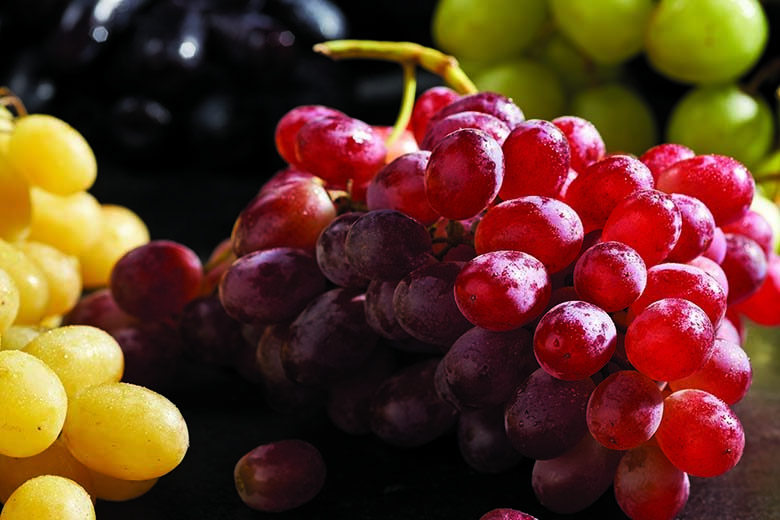
Whether you enjoy grapes raw as a snack, cooked, dried or in juice (or wine), there’s a lot to love about this fruit. Aside from being delicious and versatile, grapes provide important nutrients.
A member of the Vitaceae family, grapes are cultivated in temperate climates including Southern Europe, North America, South America, Australia and Africa. Most grapes grown in the United States are from California and are primarily red, green and black, though there are other specialty varieties. U.S.-grown grapes are in season May through January, while grapes grown in South America are available the remaining months.
Botanically a berry, grapes grow in clusters on vines and may be seedless or have seeds. The terms table, juice, wine, raisin or rootstock indicate the best use for particular grapes. For example, table grapes are grown to be visually appealing, while wine grapes are grown to be sweet, soft and juicy but may have thicker skin or more seeds. The most common types of grapes are red and green, but black, pink and yellow grapes are available in a range of shapes and flavors. Within these categories, there are hundreds of varieties: Concord, Chardonnay, Cabernet Sauvignon and so on. Different varieties thrive in different climates. For example, thinner-skinned European varieties are better suited to warmer climates. The skin of the grape is where tannins that influence flavor and most polyphenol are found.
In the Clinic: At just over 100 calories, a one-cup serving of seedless grapes is an excellent source of copper, a good source of vitamin K and provides small amounts of thiamin, riboflavin and vitamin B6. Composed of more than 80 percent water, grapes can help with hydration.
Studies have shown table grapes and grape products such as juice and wine may offer health benefits, in large part due to the polyphenol content. Grapes contain more than 1,600 health-promoting compounds with beneficial properties. Resveratrol, for example, is a polyphenol that has been studied for its antioxidant properties and potential benefits to heart health, brain health and diabetes risk reduction. The anthocyanins that give red and black grapes their color also have antioxidant properties.
In the Kitchen: Grapes can be used in many ways, from eating as a snack on their own or paired with nuts and cheese to incorporating into recipes. Freeze grapes after washing to have on hand for a refreshing snack or add fresh grapes to fruit skewers for a nutritious dessert.
The natural sweetness of grapes makes them great for jams or jellies. They also can be juiced or fermented and made into wine, which then can be made into vinegar.
Cooked grapes have a place in sweet and savory recipes. Roast grapes and pair with savory flavors such as cheese, meat, fish or poultry. Use grapes instead of or in addition to other fruits for a yogurt parfait. Dry grapes to make raisins for a flavorful garnish or on-the-go snack.
In Quantity: When purchasing, look for bunches of plump grapes firmly attached to green, pliable stems. Avoid grapes that are bruised or mushy. If you see a powdery-white coating on grapes, it’s a good thing — that bloom protects the fruit from decay and moisture loss.
As with all fresh produce, grapes must be properly washed and handled. Store fresh grapes unwashed in the refrigerator, ideally at 30 to 32 degrees Fahrenheit with 90 to 95 percent relative humidity to prolong shelf life. Store grapes in an area where air can circulate around them rather than blowing directly on them. Rinse grapes just before eating or adding to a recipe. Any grapes that fall from the stem (sometimes called “shatter”) should be eaten as soon as possible.
Grapes hold their shape well and look visually appealing, making them an attractive choice for foodservice to elevate the appeal of simple platters and dishes. They can be purchased in bulk by the crate.
References
About the FPS Grape Registry. UC Davis College of Agricultural and Environmental Sciences Foundation Plant Services: Grapes website. Accessed January 17, 2020.
All About Grapes. Grapes from California website. Accessed January 17, 2020.
Cantos E, Spin J, Tomás-Barberán F. Varietal differences among the polyphenol profiles of seven table grape cultivars studied by LC-DAD-MS-MS. J Agric Food Chem. 2002;50(20):5691-6.
oodDataCentral: Grapes, Raw. United States Department of Agriculture website. Accessed January 10, 2020.
Grape Storage and Handling. Grapes from California website. Accessed January 10, 2020.
Grapes: A Brief History. Integrated Pest Management University of Missouri website. Published August 7, 2013. Accessed January 15, 2020.
Health Research. Grapes from California website. Accessed January 17, 2020.
Know Your Commodity Grapes. Produce Bluebook Services website. Accessed January 17, 2020.
Li L, Sun B. Grape and wine polymeric polyphenols: Their importance in enology. Crit Rev Food Sci Nutr. 2019;59(4):563-579.
Pezzuto J. Grapes and human health: a perspective. J Agric Food Chem. 2008;56(16):6777-84.






